Chapter 9 Wrist and Hand
The wrist is a flexible osseo-ligamentous complex forming a connective link between the forearm and the hand. Multidirectional mobility results from the numerous multiarticular carpal bones which, along with the radio-ulnar joints, allow the hand to be positioned functionally at any angle. Stability is derived from the complex array of ligaments often injured when falling on an outstretched hand.
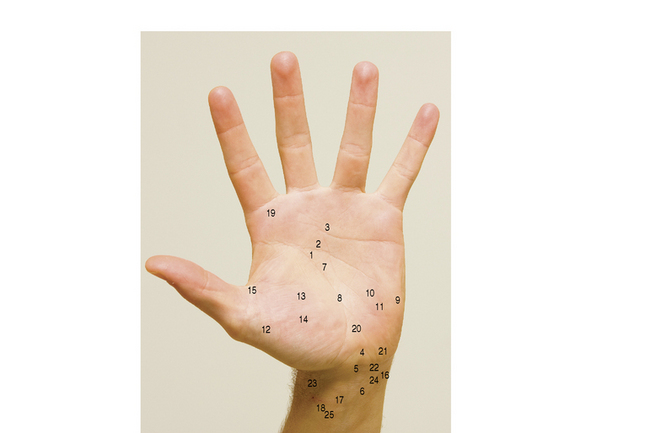
Palm of the left hand The surface markings of various structures within the wrist and hand are indicated. Not all of them are palpable, e.g. the superficial and deep palmar arches (7, 8), but their relative positions are important.
• The curved lines proximal to the base of the fingers indicate the ends of the head of the metacarpophalangeal joints.
• The creases on the fingers indicate the level of the interphalangeal joints.
• The middle crease at the wrist indicates the level of the wrist joint.
• The radial artery at the wrist (23) is the most common site for feeling the pulse. The vessel is on the radial side of the tendon of flexor carpi radialis (18) and can be compressed against the lower end of the radius.
• The median nerve at the wrist (25) lies on the ulnar side of the tendon of flexor carpi radialis (18).
• The ulnar nerve and artery at the wrist (22, 23) are on the radial side of the tendon of flexor carpi ulnaris (16) and the pisiform bone (21). The artery is on the radial side of the nerve and its pulsation can be felt, though less easily than that of the radial artery (23).
• Abductor pollicis brevis (12) and flexor pollicis brevis (13), together with the underlying opponens pollicis, are the muscles which form the thenar eminence – the ‘bulge’ at the base of the thumb. Abductor digiti minimi (9) and flexor digiti minimi brevis (10), together with the underlying opponens digiti minimi, form the muscles of the hypothenar eminence, the less prominent bulge on the ulnar side of the palm where palmaris brevis (11) lies subcutaneously.
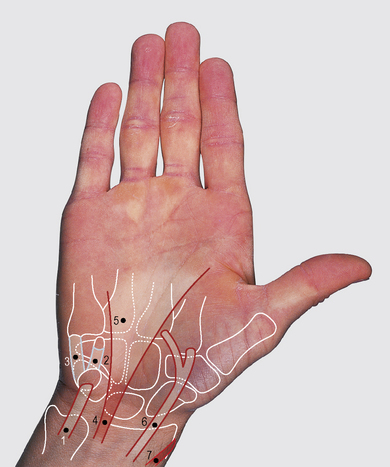
Anterior aspect of the wrist and hand: superficial tendons. 1 Flexor carpi ulnaris. 2 Pisohamate ligament. 3 Pisometacarpal ligament. 4 Palmaris longus. 5 Palmar aponeurosis. 6 Flexor carpi radialis. 7 Radial artery.
SURFACE ANATOMY


Dorsum of the left hand The fingers are extended at the metacarpophalangeal joints, causing the extensor tendons of the fingers (1, 2 and 3) to stand out, and partially flexed at the interphalangeal joints. The thumb is extended at the carpometacarpal joint and partially flexed at the metacarpophalangeal and interphalangeal joints. The lines proximal to the bases of the fingers indicate the ends of the heads of the metacarpophalangeal joints. The anatomical snuffbox (9) is the hollow between the tendons of abductor pollicis longus (7) and extensor pollicis brevis (6) laterally and extensor pollicis longus medially (5).
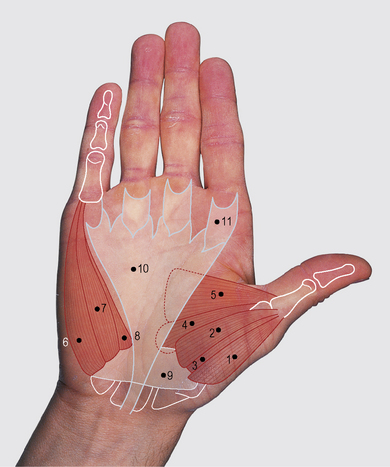
Thenar and hypothenar eminences. 1 Abductor pollicis brevis. 2 Flexor pollicis brevis. 3 Opponens pollicis. 4 Adductor pollicis oblique head. 5 Adductor pollicis transverse head. 6 Abductor digiti minimi. 7 Flexor digiti minimi. 8 Opponens digiti minimi. 9 Flexor retinaculum. 10 Palmar aponeurosis. 11 Flexor fibrous sheaths
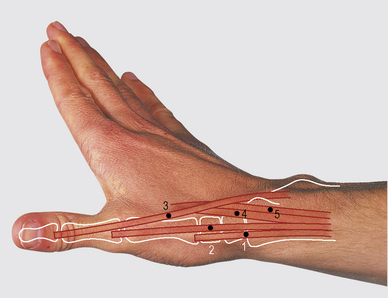
Anatomical snuffbox: tendons. 1 Abductor pollicis longus. 2 Extensor pollicis brevis. 3 Extensor pollicis longus. 4 Extensor carpi radialis longus. 5 Extensor carpi radialis brevis.
ANATOMICAL AREA: WRIST AND HAND
WRIST HYPEREXTENSION SPRAIN TAPING
Indications for use
• palmar radio-carpal ligaments sprains (hyperextension)
• for dorsal radio-carpal ligament (hyperflexion): apply the check-reins dorsally and add restraining Xs to the dorsal aspect, thus limiting end-range of flexion
• for radial collateral ligament sprain: reinforce the lateral X and add lateral palmar X to prevent ulnar deviation
• for ulnar collateral ligament sprain: reinforce the medial X and add medial palmar X to prevent radial deviation
• diffuse pain in the wrist due to repeated compression or ‘jamming’ the wrist
• Ensure that the proper diagnosis has been made to rule out fractures, particularly if the injury was caused by an outstretched hand (the scaphoid bone is the most commonly fractured).
• Clarify the mechanism of injury, whether it was hyperflexion or hyperextension that occurred.
• The use of skin toughener or quick-drying adhesive spray is essential for good adherence of taping, especially in rainy or hot conditions when hands, wrists and forearms can become quite damp.
• Wrap the circumferential strips with minimal tension, to avoid neurological or vascular compromise.
• Monitor circulatory status and sensation prior to, during and after taping.
For additional details regarding an injury example see T.E.S.T.S. chart, p. 199.
Positioning
Sitting, with the wrist in a neutral position held in slight extension (approximately 20 °).
Procedure
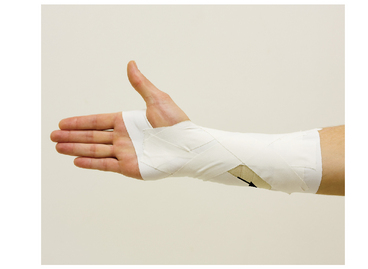
7. Start the medial X from the palmar aspect of the distal anchor to the posteromedial aspect of the proximal anchor.
8. Finish this X with a strip from the dorsal aspect of the distal anchor to the proximal anchor anteriorly with firm tension.
Stay updated, free articles. Join our Telegram channel

Full access? Get Clinical Tree



 NOTES:
NOTES: TIP:
TIP: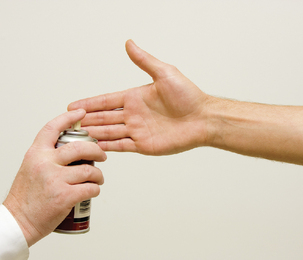
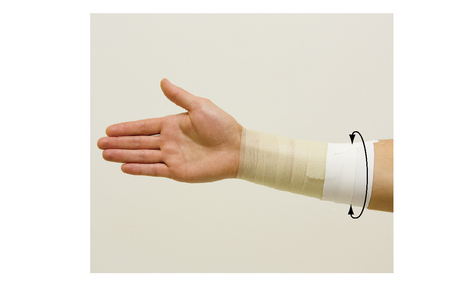
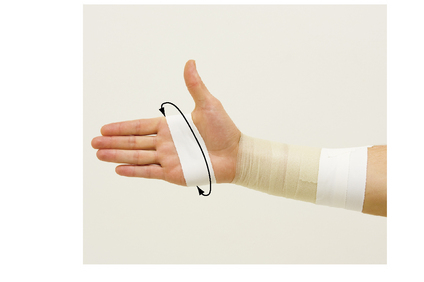
 TIP:
TIP: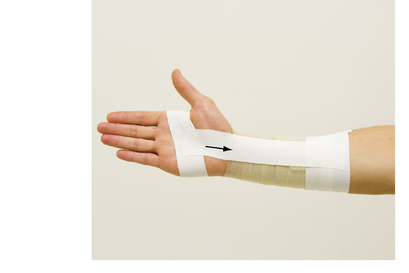
 NOTE:
NOTE:





